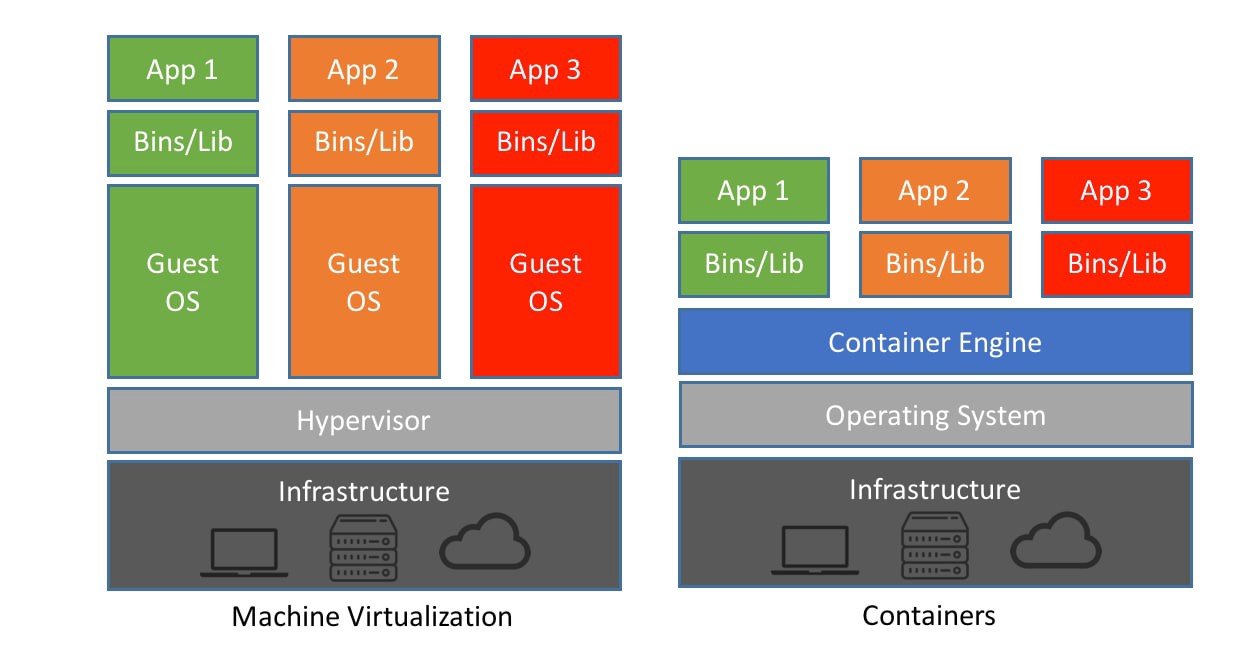When attempting to understand containers, it may be helpful to compare them to a Virtual Machine based model. In Figure 1, the left side demonstrates a VM-based model, where a hypervisor exists to virtualize hardware. This allows multiple operating systems to be installed across the same hardware due to the segmentation the hypervisor provides.
In the figure, you can see with a VM-based approach, the overhead of the OS is replicated for each isolated workload. Each app has its own host OS that must be configured. Also, consider that the OS consumes a large number of resources of its own, making it expensive to run multiple hosts.
In the container-based approach, we move the responsibility of segmentation away from the hypervisor and to the Operating System directly. This is through the use of Linux kernel capabilities: namespaces and cgroups. The kernel features provide isolation of processes, file system, networking, user management, and resource allocation.
These features allow the deployment of multiple applications on the same host OS without them being able to impact each other. The complete experience to manage these isolation capabilities is known as containerization. In Figure 1, you can see each app has its own binaries and libraries that may need to be replicated. But they all run on the same host.
Container tooling provides a simple interface for users to create isolated spaces for their apps/processes to run. Container tooling also provides the ability to save the configuration of containers as container images for portability and reusability. The images are comprised of blob layers, which inherit from each other.
Pulling an image from a remote registry fetches each blob layer independently, as seen below:
$ podman pull docker.io/library/solr
Trying to pull docker.io/library/solr:latest...
Getting image source signatures
Copying blob 223392b822f8 done
Copying blob a1327346673b done
Copying blob 0a16ebdf4435 done
Copying blob 125a6e411906 done
Copying blob ec461e3e950a done
Copying blob 32345a8973bc done
Copying blob b73138edd3c7 done
Copying blob 273f43aed7c4 done
Copying blob 4bd9a4e4bc65 done
Copying config 7452a972a2 done
Writing manifest to image destination
Storing signatures
7452a972a2d7b98ab52d2696829f2c4222856e9b78d07938cc64c3a26344bd68
When working with images, it is typical to use a "base image" that contains common libraries, and "extend" it with our unique application binaries and configuration.
Container tooling such as Docker or podman makes it easy to run containers on a single host. However, in the enterprise, we need to orchestrate applications at large scale with high availability and other features. This is where Kubernetes comes into play.
Kubernetes allows for the management of container workload lifecycles across a cluster of hosts as well as provide orchestration mechanisms such as networking abstractions, etc. Perhaps the key feature of Kubernetes is its robust API, which provides a consistent model for interaction and also customization capabilities. As you become more familiar with Kubernetes, you will begin to understand the power of its flexible APIs.
The Kubernetes API accepts JSON and YAML formats, which are important to understand in order to be successful.
https://json2yaml.com/ provides an interactive visual for comparing JSON and YAML.
Kubernetes provides resources, or Kinds, for managing containers and compute.
Note: You will commonly hear about "resources" or "kinds" when working with Kubernetes. These are interchangeable terms that refer to the type of resource.
The smallest manageable compute resource is known as a Pod. The following is a simple example of a Pod resource:
apiVersion: v1
kind: Pod
metadata:
name: myapp-pod
labels:
app: demo
annotations:
sample.io/my-annotation: some attribute value
spec:
containers:
- name: myapp-container
image: quay.io/bhouse/busybox:latest
command: ["sh", "-c", "echo Hello World! && sleep 3600"]In the Pod resource, you will notice four top level attributes:
apiVersion- Details about the API, including its version.kind- The resource type defined in the API.metadata- Metadata about the resource, including name, labels, and annotations.spec- The special configuration for the resource. Each resource defines a unique specification with attributes.
Every resource in Kubernetes has a apiVersion, kind, and metadata attribute. Most resources have the spec attribute, however, there are exceptions. Eg. Secrets and ConfigMaps.
In the metadata, we can see the Pod has a name, which needs to be unique per namespace. We will talk about these in a bit. Labels can also be specified for each resource, which are key for resource selection and interations with other resources. Labels exist as a key-value pair and a resource can have any number of labels.
The spec is where all the specification exists for the Pod. In the simple example, we specify a containers attribute which is a list.
